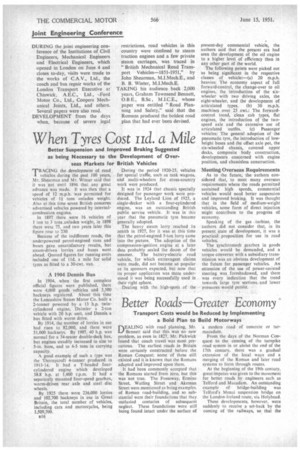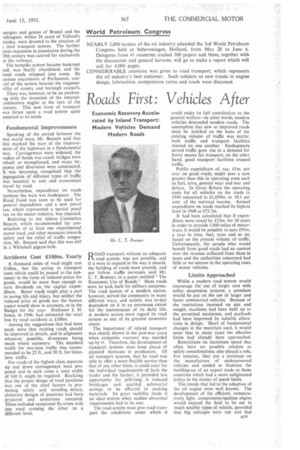Better Roads Greater Economy
Page 50

Page 53

If you've noticed an error in this article please click here to report it so we can fix it.
Transport Costs would be Reduced by Implementing a Bold Plan to Build Motorways
DEALING with road planning, Mr. Bennett said that this was no new problem, as even in 1827, Mr. Pickwick found that coach travel was most precarious. The earliest roads in Britain were certainly constructed before the Roman Conquest; some of these still existed and it is known that the Romans adapted and improved upon them.
It had been commonly accepted that the Romans started from zero, but this was not true. The Fosscway, Ermine Street, Watling Street and Akeman Street were mentioned as being examples. of Roman road-building, and so substantial were their foundations that they outlasted centuries of subsequent neglect. These foundations were still being found intact under the surface of
a modern road of concrete or tarmacadam.
From the days of the Norman Conquest to the coming of the turnpike road system in or al:whit the end of the 17th century, there was a gradual extension of the local ways and a merging of the Roman and later road systems to form through routes.
At the beginning of the 19th century, great impetus was given to the movement for better roads by engineers such as Telford and Macadam. An outstanding example of bridge-building was Telford's Menai suspension bridge on the London-Ireland route, via Holyhead.
These developments, however, were suddenly to receive a set-back by the coming of the railways, so. that the
:nergies and genius of Brunel and his :olleagues, within 20 years of Telford's leyday, were devoted to the creation of rival transport system. The further treat expansion in population during the 19th century was catered for exclusively iy the railways. The turnpike system became bankrupt incl, was finally abandoned, and the rural roads relapsed into coma. By mrious enactments of Parliament, conrol of the system became the responsi'flay of county and borough councils.
There was, however, to be an awakenng with the invention of the internal:ombustion engine at the turn of the :entury. This new form of transport was thrust upon a road system quite unsuited to its needs.
Fundamental Improvements
• Speaking of the period between the two world wars, Mr. Bennett said that this marked the start of the improvement of the highways in a fundamental way. Carriageways were widened, the radius of bends was eased, bridges were rebuilt or strengthened, and many bypasses and diversions were constructed. It was becoming recognized that the segregation of different types of traffic was essential to safe and economical travel by road.
Nevertheless, expenditure on roads between the wars was inadequate. The Road Fund was soon to be used for general expenditure and a new petrol tax, which represented a special penal tax on the motor industry, was imposed.
Referring to the Alness Committee Report, which recommended the construction of at least one experimental motor road, and other measures towards safety and the relief of traffic congestion, Mr. Bennett said that this was still in a Whitehall pigeon-hole.
Accidents Cost £100m. Yearly
A thousand miles of road might cost £100m., but the saving in transport costs which could be passed to the consumer in the form of reduced prices for goods, would be more than enough to earn dividends on the capital expenditure. Better roads might play a part in saving life and injury, but neither the reduced price of goods nor the human aspect would show in accounts, or in the Budget for the year. Professor J. H. Jones, in 1946, had estimated the total loss by road accidents at £100m.
Among the suggestions that had been made were that existing roads should be improved in details, and in alignment wherever possible, diversions being made where necessary. The standard width for two-lane traffic was recommended to be 22 ft., and 30 ft. for threelane traffic.
For roads of the highest class, separate up and down carriageways were proposed and in such cases a total width of 160 ft. might be required. Realizing that the proper design of road junctions was one of the chief factors in promoting safety and avoiding delays, elaborate designs of junctions had been prepared and sometimes executed. These included occasional fly-overs with one road crossing the other on a different level.




























































































